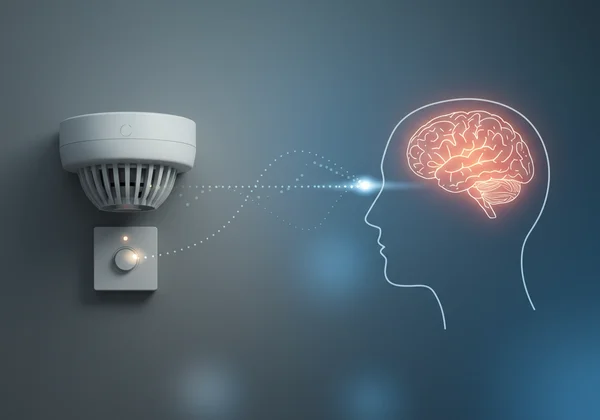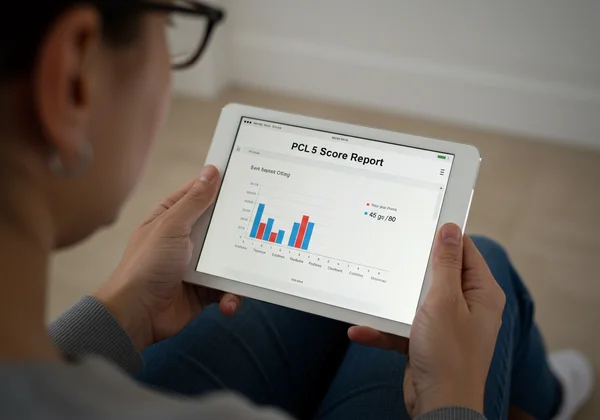Can the PCL-5 Diagnose PTSD? Understanding Your Score
If you’ve taken the PCL-5, you likely have one pressing question: "Can this test diagnose me with PTSD?" The short answer is no, but your score is a crucial first step. It’s natural to feel a mix of anxiety and urgency while seeking answers, and this guide is here to provide clarity. We will explain the vital difference between a PCL-5 screening and a formal clinical diagnosis, helping you understand your results and know what responsible steps to take next.
Taking the first step toward understanding your experiences is courageous. A tool like the PCL-5 isn't meant to provide a label, but to offer a starting point for reflection and, if needed, conversation. Let's walk through what your PCL-5 score means and how it fits into the bigger picture of mental wellness.
PCL-5: A Screening Tool, Not a Diagnostic Instrument
It is essential to first understand that the PCL-5 (PTSD Checklist for DSM-5) is a screening instrument, not a diagnostic one. Think of it like a smoke detector. A smoke detector can alert you to the potential presence of a fire, giving you a critical early warning. However, it can't tell you the fire's size, cause, or exact location. For that, you need a firefighter to assess the situation. The PCL-5 functions similarly; it flags potential concerns related to Post-Traumatic Stress Disorder. Just as you wouldn't ignore a smoke alarm, you shouldn't ignore a concerning PCL-5 score. Both signal that a closer look by an expert is necessary.

This distinction is not just a matter of semantics; it's a cornerstone of responsible mental health practice. A screening tool is designed to be accessible, quick, and efficient at identifying individuals who might benefit from a more thorough evaluation. It opens the door to awareness, but a qualified professional must be the one to walk through it with you to see what's on the other side.
What Does a PCL-5 Score Mean?
When you complete the PCL-5 questionnaire, you receive a number from 0 to 80. This number is a quantitative measure of your PTSD symptom severity over the past month. It is a "snapshot" of your current level of distress. A higher score generally suggests a greater severity and frequency of symptoms, which often fall into four main categories:
- Intrusive Memories: Such as flashbacks or nightmares.
- Avoidance: Avoiding people, places, or thoughts related to the trauma.
- Negative Changes in Mood: Persistent feelings of fear, anger, guilt, or numbness.
- Hyperarousal: Feeling jumpy, being easily startled, or having trouble sleeping.
However, your PCL-5 score is not a definitive label. It is a piece of data that provides insight into how much trauma-related symptoms may be impacting your daily life. It helps translate subjective feelings into a more objective metric, which can be an incredibly validating experience. This score can help you say, "I'm not just imagining it; these feelings are real and significant." It is a point of reference for your personal journey or for a future discussion with a healthcare provider.
Why Screening is a Powerful First Step
Taking an online PCL-5 assessment is an empowering and proactive step in managing your mental well-being. In a world where mental health support can sometimes feel out of reach, tools like the one offered at Pcl5.com provide a confidential, accessible, and immediate first look at your symptoms. You can complete the questionnaire in the privacy of your own home, on your own time.
This initial step removes barriers and provides valuable information without pressure. For many, simply seeing a score helps to organize their thoughts and validate their experiences. It can be the catalyst that encourages someone to seek further help. Our confidential PCL-5 test is designed to give you this powerful first step, providing a free, instant score based on the official DSM-5 criteria.
Limitations of the PCL-5 Self-Assessment
While incredibly useful, it's crucial to acknowledge the limitations of any self-assessment tool. The PCL-5 cannot capture the full, rich context of your life. It doesn't know about your personal history, your support system, your resilience, or any other co-occurring conditions you might be experiencing. It's a structured list of questions, not a dynamic, understanding conversation.
Symptoms of PTSD can often overlap with other conditions like Major Depressive Disorder, Generalized Anxiety Disorder, panic disorder, or substance use disorders. Complex trauma (C-PTSD) can also present with overlapping symptoms. A self-assessment cannot differentiate these nuances. This is why a score, no matter how high or low, should be viewed as an indicator, not a verdict. True understanding comes from a comprehensive evaluation that considers you as a whole person.
The Formal PTSD Diagnosis Process: What to Expect
If the PCL-5 is the smoke detector, a formal PTSD diagnosis process is the full inspection by a trained professional. A diagnosis is a much more thorough and holistic process conducted by a licensed mental health professional, such as a psychologist, psychiatrist, or clinical social worker. It goes far beyond a simple score from a questionnaire.
This process is designed to be comprehensive to ensure you receive the most accurate and helpful guidance possible. It’s a collaborative effort between you and a clinician to build a complete picture of your health. A proper assessment ensures that any treatment plan is tailored specifically to your unique needs and circumstances.
Step 1: The Comprehensive Clinical Interview
The cornerstone of any diagnostic assessment is the clinical interview. This is a guided conversation where a trained professional will ask you questions about your experiences. They will want to understand the context of the traumatic event(s), the specific nature of your symptoms, and how they affect your work, relationships, and overall quality of life.

This conversation allows for a depth of understanding that a questionnaire can't provide. The clinician can ask follow-up questions, clarify your responses, and observe non-verbal cues. This human element is irreplaceable. It's an opportunity for you to share your story in a safe, non-judgmental space and for the professional to gather the detailed information needed for an accurate picture. Using your score from our online tool can be an excellent way to begin this conversation.
Step 2: Differential Diagnosis (Ruling Out Other Conditions)
A key responsibility of a clinician is to rule out other conditions that could be causing your symptoms. As mentioned, the symptoms of PTSD—like trouble sleeping, irritability, and difficulty concentrating—can overlap significantly with other mental health challenges. For instance, is the avoidance you're experiencing a symptom of PTSD or social anxiety? Is the emotional numbness related to trauma or depression?
A professional uses their expertise and diagnostic manuals to differentiate between these conditions. This process, known as differential diagnosis, is critical. An accurate diagnosis ensures you receive the most effective treatment. Misdiagnosing the issue could lead to a treatment plan that doesn't address the root cause of your distress.
Step 3: Applying Official DSM-5 Criteria for PTSD
Clinicians rely on the Diagnostic and Statistical Manual of Mental Disorders, Fifth Edition (DSM-5) to make a formal diagnosis. This manual, published by the American Psychiatric Association, provides the official criteria for diagnosing mental health disorders, including PTSD. The PCL-5 is based on these criteria, but a diagnosis requires more than just checking off symptoms.
To be diagnosed with PTSD, an individual must meet a specific number of symptoms across all four of the main symptom clusters (Intrusion, Avoidance, Negative Alterations in Cognition and Mood, and Alterations in Arousal and Reactivity). A clinician evaluates your symptoms against these strict criteria, considering their duration, intensity, and the functional impairment they cause. A score from the PCL-5 can suggest these criteria might be met, but only a clinical evaluation can confirm it.
Your Score Is a Starting Point, Not a Final Word
To circle back to our original question: Can the PCL-5 diagnose PTSD? The answer is a clear and definitive no. The PCL-5 is an invaluable, scientifically validated screening tool that can identify potential symptoms of PTSD and measure their severity. It empowers you with knowledge and serves as a crucial first step toward understanding your mental health.
Your score is a key piece of information—a starting point, not a final word. View it as a catalyst for action. If your score indicates a level of distress that concerns you, the next responsible step is to share this information with a doctor or a qualified mental health therapist. It can serve as the perfect icebreaker for a meaningful and productive conversation.
Ready to gain a better understanding of your symptoms? Start your free assessment on our confidential platform. Get your score instantly and use it as a tool to prepare for a conversation with a professional who can guide you on the path to feeling better.
Answering Your Questions About the PCL-5
What is considered a high PCL-5 score?
A score of 31-33 is often used as a provisional cutoff score, suggesting that PTSD symptoms are severe enough to warrant a full clinical assessment. However, this is not a 'passing' or 'failing' number—it's a guideline. Someone with a lower score might still be struggling significantly, while a higher score requires professional context. The score's true meaning is only clear when discussed with a qualified mental health provider.

Can the PCL-5 be used to monitor symptoms over time?
Absolutely. This is one of the PCL-5's greatest strengths. Because it provides a numerical score, it is an excellent tool for symptom tracking over time. Both you and your therapist can use it to monitor if a treatment plan is effective or if adjustments are needed. Taking the PCL-5 at regular intervals (e.g., monthly) provides objective feedback on your recovery journey, which you can do easily with our PCL5 questionnaire.
Is an online PCL-5 test reliable?
An online PCL-5, like the one on our site, is reliable for its intended purpose: screening. It uses the same official questions and scoring method. Its reliability depends on your honest self-reporting of symptoms. While it provides a reliable screening score, it is not a substitute for a formal clinical evaluation, which is required for a reliable diagnosis.